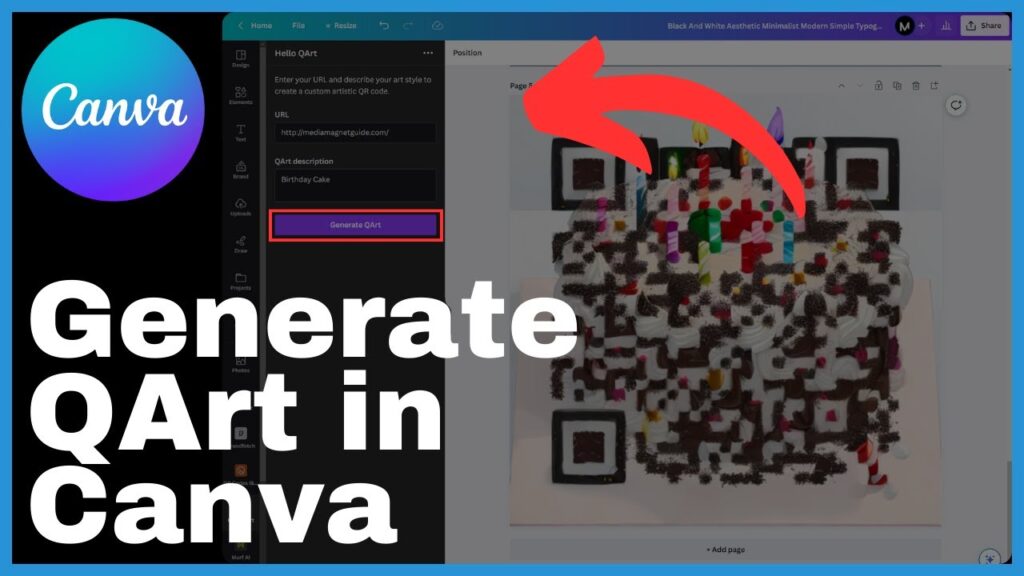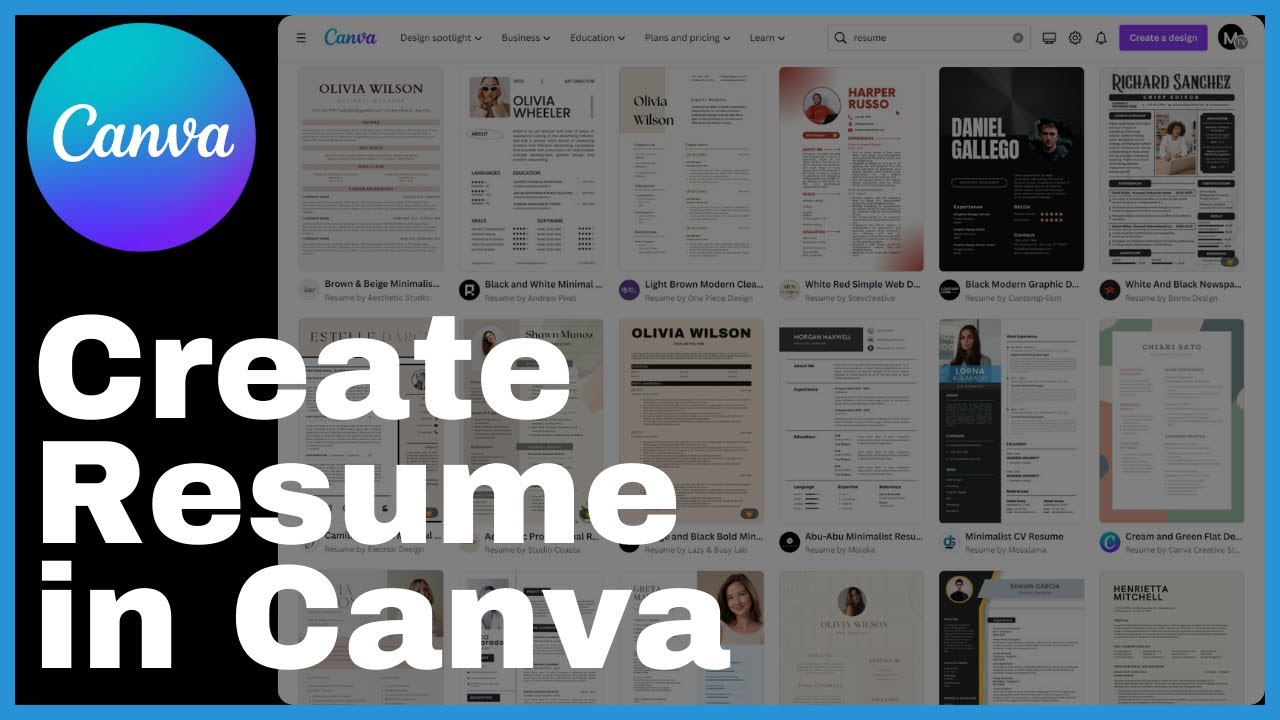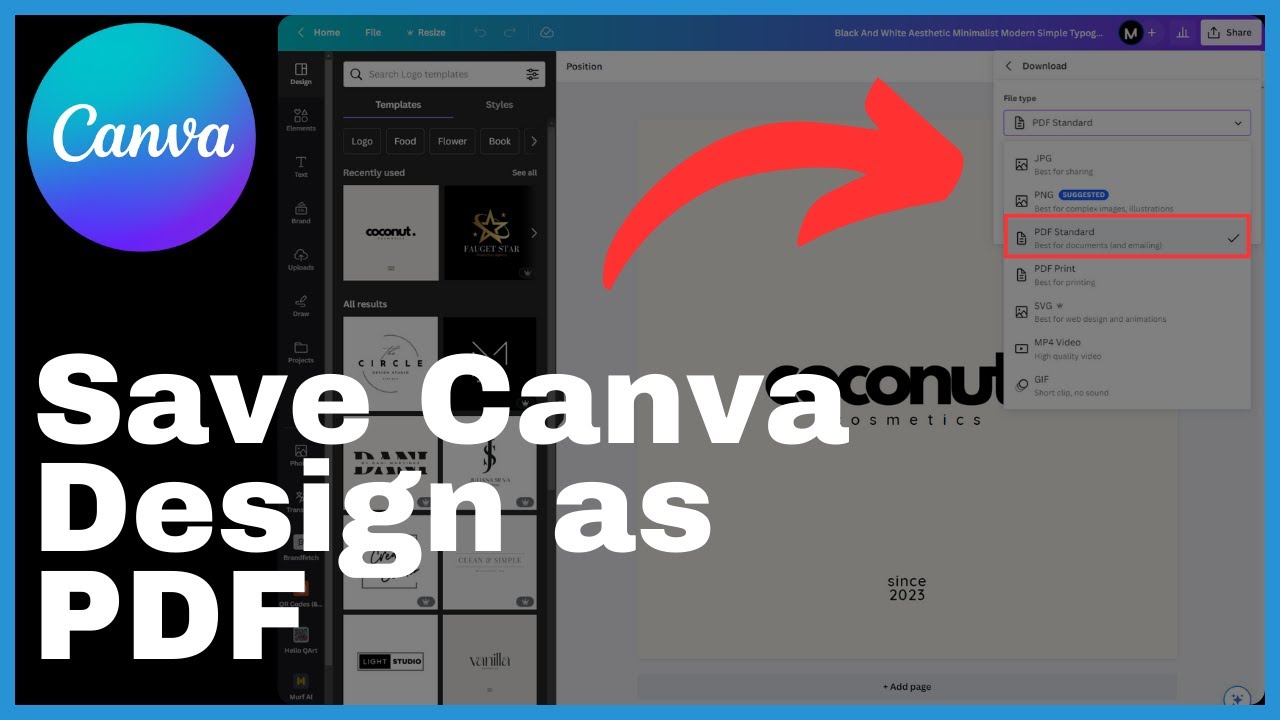This article titled “How To Generate QArt In Canva” provides a step-by-step tutorial on how to generate unique QArt codes in Canva. The video, created by Media Magnet Guide, offers a demonstration of the process and highlights the benefits of utilizing Canva’s design platform. The article also encourages readers to explore more Canva tutorials and join the channel as a member to support the content creation journey. In the video, viewers are guided through the process of creating QR codes with custom images and text prompts using Canva’s hello Q Art feature. The tutorial begins with opening Canva’s website and navigating to the Apps icon on the dashboard. From there, users can search for the hello keyword icon to access the hello keyart interface. By following the provided instructions, individuals can generate personalized QR codes with embedded images and text prompts, enhancing their marketing materials or adding a creative touch to their projects. The article concludes with a call to action, urging viewers to like, comment, and subscribe for more valuable content.

Understanding QArt and Canva
Definition of QArt
QArt is a feature on Canva that allows users to generate customized QR codes. QR codes are two-dimensional barcodes that can be scanned using a smartphone or other similar device to access information or content embedded in the code. QArt takes QR codes to the next level by allowing users to add images and text prompts to their codes, making them more visually appealing and engaging.
Definition of Canva
Canva is an inclusive design platform that enables users to create a wide range of visual content, such as social media graphics, presentations, posters, and more. It offers a user-friendly interface with drag-and-drop functionality, making it accessible to individuals with varying levels of design experience. Canva provides users with a vast library of templates, images, fonts, and other design elements, allowing them to express their ideas and creativity in a visually appealing way.
Brief overview of Canva’s features
In addition to its QArt feature, Canva offers a range of other features to enhance the design process. These include a vast library of templates, images, icons, and fonts; the ability to collaborate with team members on design projects; and the option to export designs in various formats. Canva also provides integrations with other platforms and applications, allowing users to streamline their design workflows.
Creating a Canva Account
Steps to sign up for a Canva account
To create a Canva account, follow these simple steps:
- Open your web browser and navigate to Canva’s website.
- Click on the “Sign up” button located at the top right corner of the webpage.
- You can sign up using your Google account, Facebook account, or email address. Choose the option that suits you best and follow the prompts to complete the sign-up process.
Benefits of having a Canva account
There are several benefits to creating a Canva account:
- Access to a wide range of design templates and elements: With a Canva account, you can explore and use Canva’s extensive library of templates, images, fonts, and icons to create professional-looking designs.
- Collaboration and teamwork: Canva allows users to collaborate on design projects by inviting team members to edit and contribute to designs, making it easy to work together on creative projects.
- Seamless design workflow: Having a Canva account allows you to save and edit your designs, making it easy to update and modify them whenever necessary.
- Cross-device functionality: Canva is available on any device with an internet connection, ensuring that you can access your designs and work on them from anywhere.
Overview of Canva dashboard
Once you have created a Canva account and logged in, you will be directed to the Canva dashboard. The dashboard serves as a central hub for all your design projects. Here, you can access your saved designs, create new designs from scratch, or explore Canva’s library of templates and design elements. The dashboard provides a user-friendly interface with intuitive navigation, making it easy to find and manage your design projects.
Navigating through Apps on Canva
Locating the Apps icon on Canva dashboard
To access the Apps section on Canva, you can locate the Apps icon on the Canva dashboard. The Apps icon is typically found in the left-hand sidebar of the dashboard. Clicking on the Apps icon will open a list of available apps and integrations that you can explore and use within Canva.
Browsing through the list of available apps and integrations
Within the Apps section, you will find a list of available apps and integrations that can enhance your design process. These apps and integrations offer additional functionalities and features that you can utilize within Canva. Browse through the list to discover the apps and integrations that align with your design needs and preferences.
Using the search bar within the apps section
If you are looking for a specific app or integration within the Apps section, you can use the search bar to quickly locate it. Simply type in the name or relevant keywords of the app or integration you are looking for and press Enter. Canva will display the search results, allowing you to find and access the desired app or integration with ease.
Locating the QArt Feature on Canva
How to find the QArt tool in the apps section
To find the QArt tool in the Apps section of Canva, follow these steps:
- Open the Canva dashboard and locate the Apps icon in the left-hand sidebar.
- Click on the Apps icon to open the list of available apps and integrations.
- Within the Apps section, use the search bar to search for “QArt” or “QR codes.”
- Canva will display the QArt tool in the search results. Click on the QArt tool to open it.
Intro to the QArt interface
Once you have accessed the QArt tool in Canva, you will be greeted with an intuitive interface designed to facilitate the creation of customized QR codes. The interface will consist of various elements such as input fields for links and text prompts, preview sections for visualizing the QR codes, and options for customization and generation.
Overview of QArt’s features
QArt offers a range of features to customize and enhance QR codes:
- Link attachment: QArt enables users to attach a link to their QR codes, allowing the codes to direct users to specific websites, online content, or landing pages.
- Text prompt: In addition to adding a link, QArt allows users to enter a text prompt that describes the content or purpose of the QR code. This text prompt can help users understand what the QR code leads to.
- Customization options: QArt provides users with options to customize the appearance of their QR codes, such as adding images, changing colors, and adjusting size and placement. These customization options allow users to create visually engaging QR codes that align with their branding or design preferences.
Creating QArt Codes in Canva
Step by step process of generating QArt codes
To generate QArt codes in Canva, follow these step-by-step instructions:
- Open the QArt tool within the Canva Apps section.
- Paste the desired link into the designated field. This link should be the destination that users will be directed to when scanning the QR code.
- In the description box, enter a text prompt that describes the content or purpose of the QR code.
- Click on the “Generate QArt” button to process your request.
- Canva will generate the QR code with the embedded link and display it on the screen.
Adding a description to the QArt code
When creating QArt codes in Canva, it is recommended to add a description to the code. The description serves as a text prompt that provides additional context or information about the QR code’s content or purpose. This description helps users understand what they can expect when scanning the code and encourages them to engage with it.
Importance of attaching a relevant link to the QR code
Attaching a relevant link to the QR code is essential as it determines where users will be directed when scanning the code. The link should lead to content or information that is relevant to the QR code’s purpose or context. Whether it’s a website, blog post, video, or other online content, ensure that the linked destination provides value to users and aligns with the intended use of the QR code.
Generating Your First Custom QArt Code
Entering the link and description
To generate your first custom QArt code, follow these steps:
- Open the QArt tool in Canva.
- Paste the link you want to attach to the QR code into the designated field.
- In the description box, enter a text prompt that describes the content or purpose of the QR code.
Generating the QArt
After entering the link and description, click on the “Generate QArt” button to initiate the QR code generation process. Canva will process your request and generate the QR code with the embedded link and description.
Outcome of generated QArt and how to download
Once the QR code has been generated, you will see it displayed on the screen. The QR code will be fully scannable, and users can use their smartphones or other QR code scanning devices to access the linked content. To download the QR code, simply click on the download button provided by Canva.
Creating Additional QArt Codes
How to create multiple QArt codes
To create multiple QArt codes in Canva, follow these steps:
- Repeat the process of generating QArt codes described earlier: entering the link and description, and clicking on the “Generate QArt” button.
- Customize each QR code by adjusting the appearance, such as adding images, changing colors, or resizing.
- Download each QR code individually.
Tips for creating an array of QR codes
When creating an array of QR codes, consider the following tips:
- Organize and label your QR codes: Keep track of the different QR codes you create by labeling them or organizing them into folders within your Canva account. This will make it easier to manage and use them in the future.
- Test your QR codes: Before using or sharing your QR codes, it’s essential to test them to ensure they work as intended. Use QR code scanning devices or smartphone apps to test the codes and make sure they direct users to the correct destinations.
- Monitor and update your QR codes: As content or information linked to QR codes may change over time, it’s important to regularly monitor and update your QR codes if necessary. This ensures that users always have access to relevant and up-to-date content.
Potential usage of different QR codes
Different QR codes can serve various purposes and be used in different contexts. Some potential uses of QR codes include:
- Marketing materials: QR codes can be added to marketing materials such as posters, flyers, brochures, or business cards to provide quick and convenient access to additional information or special offers.
- Product packaging: QR codes can be incorporated into product packaging to offer customers easy access to product instructions, reviews, or promotional content.
- Event promotions: QR codes can be used in event promotions to provide attendees with additional event details, maps, schedules, or exclusive content.
- Educational materials: QR codes can be included in educational materials to provide supplementary resources, interactive content, or access to online quizzes or activities.
Practical Applications of Custom QArt Codes
Importance of personalized QR codes
Personalized QR codes offer several benefits:
- Brand recognition: By customizing QR codes with specific images, colors, and branding elements, businesses and individuals can enhance their brand presence and recognition.
- Increased engagement: Visually appealing and personalized QR codes are more likely to attract users’ attention and encourage them to scan the codes, leading to increased engagement with the linked content.
- Enhanced user experience: Personalized QR codes can provide a unique and memorable user experience, allowing users to connect with brands or individuals on a deeper level.
Enhancing marketing materials with QArt codes
Adding QArt codes to marketing materials can bring numerous advantages to businesses:
- Trackable analytics: QArt codes can provide businesses with valuable analytics data, allowing them to track the number of scans, locations, and user demographics. This information can help businesses make informed decisions and optimize their marketing strategies.
- Interactive content: QR codes can be used to unlock interactive content, such as videos, surveys, or games. Incorporating QR codes into marketing materials can make the content more engaging and memorable for potential customers.
- Seamless user experience: By providing quick and convenient access to additional information or promotional offers, QR codes enhance the overall user experience and make it easier for customers to engage with a brand.
Creative ways to incorporate QArt codes in projects
There are countless creative ways to incorporate QArt codes into various projects:
- Art and design projects: Incorporate QArt codes into art installations, posters, or digital artworks to add an interactive element or to provide additional information about the artwork.
- Wedding or event invitations: Include QArt codes on wedding or event invitations to provide guests with links to RSVP forms, event details, or even personalized messages.
- Restaurant menus: Attach QArt codes to restaurant menus to provide customers with quick and detailed information about specific dishes, including ingredients, nutritional information, or chef recommendations.
- Real estate listings: Add QArt codes to real estate listings to offer potential buyers virtual tours, additional property information, or contact details for scheduling property viewings.
Tips and Tricks for Better QArt Generation
Best practices when generating QArt
To ensure optimal results when generating QArt codes, consider the following best practices:
- Choose high-quality images: When adding images to your QArt codes, use high-resolution images that are clear and visually appealing. This will enhance the overall appearance and scannability of the QR codes.
- Keep it simple and readable: Avoid overcrowding the QR code design with too many elements or excessive text. Ensure that the QR code remains scannable and readable by keeping the design clean and straightforward.
- Test on different devices: Test your QR codes on various devices and QR code scanning apps to ensure compatibility and functionality. This will help identify any issues or errors beforehand and ensure a seamless user experience.
Common pitfalls and how to avoid them
When generating QArt codes, watch out for these common pitfalls:
- Insufficient contrast: Ensure that there is enough contrast between the QR code and the background. Low contrast can make the QR code difficult to scan, resulting in a poor user experience.
- Link and description accuracy: Double-check the accuracy of the link and description you are attaching to the QR code. Make sure the link is active and leads to the intended content.
- Proper sizing: Pay attention to the appropriate sizing of the QR code. If the code is too small, it may become difficult to scan, while a QR code that is too large may not fit properly on your desired medium.
Additional resources for creating engaging QArt
To further enhance your QArt generation skills and explore more creative possibilities, consider utilizing these additional resources:
- Canva Design School: Canva offers a Design School that provides tutorials, tips, and inspiration to help you elevate your design skills and create engaging visual content. Explore the Canva Design School for in-depth tips and insights on QR code design.
- Webinars and online courses: Keep an eye out for webinars and online courses that focus on QR code design and best practices. These resources often provide practical guidance and real-life examples to inspire and inform your QArt creations.
Conclusion
In conclusion, Canva’s QArt feature offers users the opportunity to generate unique and engaging QR codes. By following the step-by-step process outlined in this article, users can easily create customized QR codes with embedded images and text prompts. These personalized QR codes can be utilized in various contexts, such as marketing materials, educational materials, or art projects. Canva’s user-friendly interface, extensive library of design elements, and integration capabilities make it a powerful platform for creating visually appealing and interactive content. We encourage users to explore Canva’s other features and functionalities to unlock their full creative potential.

























